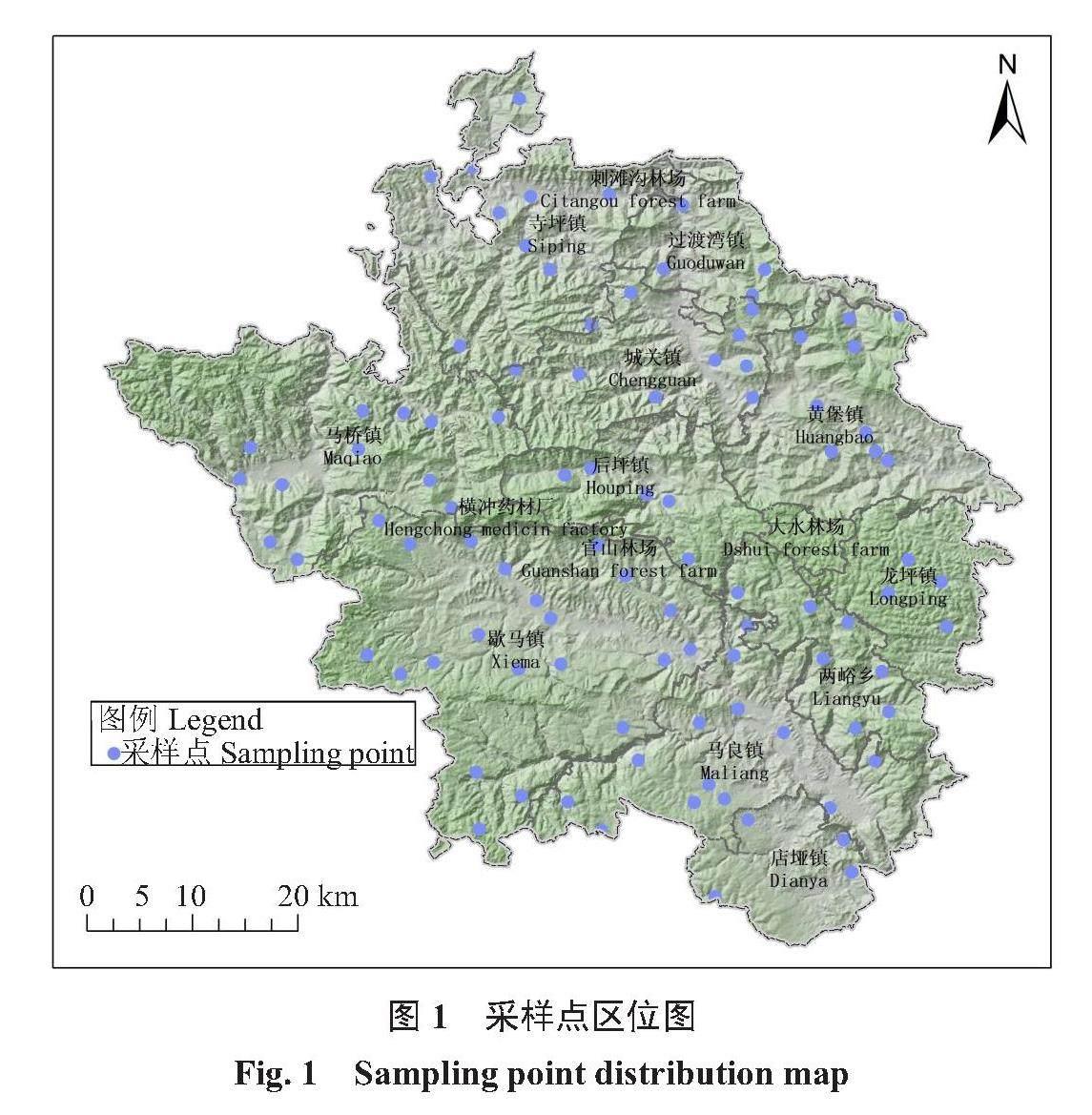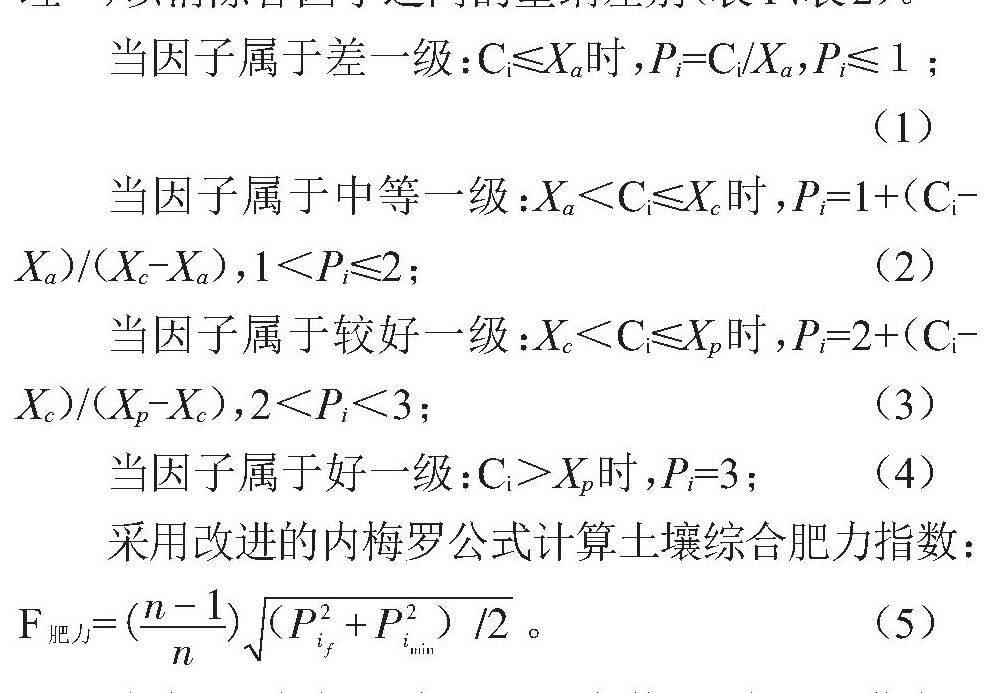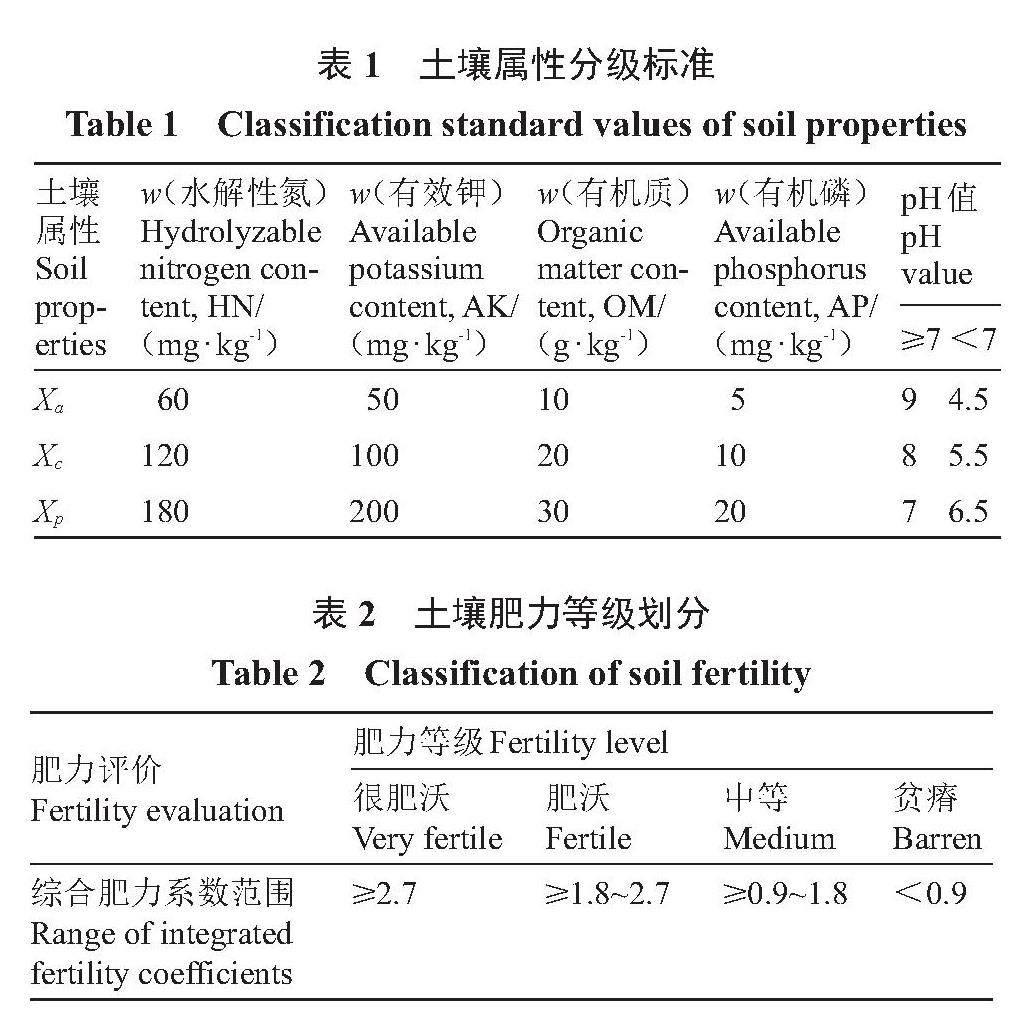基于地统计分析的核桃园土壤养分空间特征研究
徐雅雯 吴文丰 王其竹 王代全 徐朝煜 陈万胜 徐永杰



DOI:10.13925/j.cnki.gsxb.20230562
摘 要:【目的】探究核桃园土壤养分的空间特征,了解土壤肥力状况,为核桃园管理单位划分提供依据,从而实现精准施肥。【方法】以湖北保康核桃园为研究对象,采用地统计学和内梅罗法相结合的方法,分析了110块样地的土壤pH值、养分空间特征及肥力水平。【结果】(1)保康县核桃园土壤pH均值为6.68,以中性和微酸性土壤为主,具有弱变异性;有机质、水解性氮、有效钾、有效磷含量(w,后同)均值分别为27.63 g·kg-1、109.41 mg·kg-1、125.43 mg·kg-1和23.74 mg·kg-1,具中等变异。(2)中等肥力核桃园占78.3%,肥沃核桃园占20.7%,水解性氮是土壤肥力的主要限制因子;土壤肥力指数与核桃干果每666.7 m2产量呈显著正相关。(3)水解性氮、有效钾含量主要受自然结构的影响,呈现显著空间正向聚集性;有机质、有效磷含量受自然结构和人为因素的双重影响,具有空间正相关性,但空间聚集效应不显著。(4)海拔与水解性氮含量、有效磷含量、土壤肥力指数呈极显著正相关,与有机质含量呈显著正相关,而与有效钾含量无显著相关性。【结论】该地区土壤pH值适宜核桃生长,现存核桃园整体肥力中等偏上,提高土壤肥力能够增加核桃干果产量。土壤空间变异主要受自然结构的影响,其中海拔是影响土壤肥力的关键因素,可以作为核桃园管理单元划分的重要依据。在土壤管理中,需要增施氮肥以提高林地土壤综合肥力。
关键词:核桃;地统计;土壤养分;空间分布特征
中图分类号:S664.1 文献标志码:A 文章编号:1009-9980(2024)05-0968-12
收稿日期:2024-01-09 接受日期:2024-02-23
基金项目:国家林业和草原局林业植物新品种及专利保护应用项目(KJZXXP202309);湖北省重点研发计划项目(2022BBA153);湖北省林业科技支撑重点项目([2022]LYKJ10);中央财政林业科技推广示范项目(鄂[2024]TG18)
作者简介:徐雅雯,助理研究员,硕士,主要从事林木遗传育种研究。E-mail:469751394@qq.com
*通信作者 Author for correspondence. E-mail:498674563@qq.com
果 树 学 报 2024,41(5): 968-979
Journal of Fruit Science
Spatial distribution characteristics of soil nutrients in walnut orchards based on geostatistical model
XU Yawen1, WU Wenfeng1, WANG Qizhu2, WANG Daiquan2, XU Chaoyu2, CHEN Wangsheng2, XU Yongjie1*
(1Hubei Academy of Forestry, Wuhan 430075, Hubei, China; 2Center for Walnut Technology of Baokang County, Xiangyang 441600, Hubei, China)
Abstract: 【Objective】 Despite the importance of soil nutrient management in walnut orchards, there is little research focusing on the spatial characterization of soil nutrients and the impact of topography on nutrient distribution and overall fertility. Consequently, the purpose of this study was to elucidate the current state of soil nutrient content and fertility, as well as to investigate the spatial characteristics of soil nutrients in walnut orchards. The findings are intended to inform the division of management units within these orchards, making it easier to establish focused and accurate fertilization strategies. Finally, the study aims to enhance soil nutrient management and contribute to the sustainable and efficient production of walnut orchards. 【Methods】 In this study, a 5 km grid was used to designate 110 plots of walnut orchards in Baokang County. Soil properties, including pH value, organic matter, hydrolyzable nitrogen, available potassium, and available phosphorus, were tested. Soil fertility was thoroughly evaluated using both statistical analysis and the Nemerow index method. Geostatistical analyses were performed using GS+9.0 software to fit the variogram and select the optimal model. Morans index was employed to assess the spatial autocorrelation of soil nutrients in the study area, with local spatial autocorrelation clusters identified using local Morans Ⅰ. Kriging method was applied for spatial optimal unbiased interpolation, and spatial distribution maps were created using ArcGIS software. 【Results】 In Baokang Countys walnut orchards, the average soil pH was 6.68, indicating predominantly neutral to slightly acidic conditions with weak variability. Mean values for hydrolyzable nitrogen (HN), available potassium (AK), organic matter (OM), and available phosphorus (AP) were 109.41 mg·kg-1, 125.43 mg·kg-1, 27.63 g·kg-1, and 23.74 mg·kg-1, respectively, each exhibiting moderate variability. According to the Nemerow index, the soil fertility index ranged from 0.90 to 2.26, with an average of 1.57. Approximately 78.3% of the land was categorized as moderately fertile, and 20.7% as fertile. In analyzing the facultative properties of soil nutrients, it was found that HN, AK, OM, and AP, as well as the comprehensive soil fertility, predominantly exhibited clustered distributions. Concerning the directional trends: HN concentrations were observed to be higher in the eastern and southern regions, with lower concentrations in the western and northern areas. AK displayed a localized polar distribution. AP concentrations were predominantly higher in the central and eastern regions compared to other areas. Finally, OM exhibited a trend of being higher in the eastern and western regions while lower in the northern and southern parts. These spatial and directional trends provide insights into the heterogeneous distribution of soil nutrients, which is critical for targeted soil management and fertilization strategies in walnut orchards. Notably, HN scores were significantly lower than other soil indices, indicating it as a primary limiting factor in soil fertility. Correlation analysis of soil fertility index and average acreage yield of walnut dry fruits showed that soil fertility was significantly positively correlated with dry fruit yield. The ranges of HN, AK, OM, and AP contents were 8.175, 5.421, 7.440, and 6.634 km, respectively, which were larger than the sampling distances, indicating that they could satisfy the needs of spatial analysis. The coefficients of determination were 0.894, 0.724, 0.742, and 0.844, respectively, which were larger than 0.5, indicating that the fitting effect was good under the corresponding theoretical model, and the spatial variability of soil nutrients was more accurately reflected by the spatial variability. Spatial autocorrelation analysis of the soil revealed that HN and AK block base ratios were 14.4% and 15.6%, respectively, with block base ratios below 25%, suggesting influence predominantly from natural structures. Conversely, OM and AK block base ratios were 35.2% and 39.2%, respectively, indicating influence from both natural structures and stochastic factors. All MoransⅠ values of soil nutrients in the study area were positive, denoting a significant spatial aggregation. Z-values of Morans index for HN and AK were 4.30 and 3.05, respectively, with p<0.05, which indicated that there were significant spatial aggregation effects for both of them; while z-values of AP and OM were 0.63 and 0.98, respectively, and the aggregation effect of the two was not significant (p>0.05). High-value nutrient aggregation areas were primarily in higher elevations like Longping Township, with lower values in lower elevations such as Maqiao and Dianya Townships. Elevation significantly influenced soil fertility, showing a strong positive correlation with HN and AP content, a significant correlation with OM content, and no significant correlation with AK content. 【Conclusion】 The soil pH in the area, predominantly neutral to slightly acidic, is conducive to walnut growth. Currently, the overall fertility of the walnut orchards ranges from medium to high, indicating a beneficial environment for walnut cultivation. Despite this, there is room for improvement in soil fertility to further enhance walnut yields. It is well-established that better soil fertility correlates with higher yields of walnut dry fruit. The management of walnut orchards at the county scale tends to be basic, with soil nutrient content primarily influenced by natural structures and secondarily by anthropogenic activities. Elevation is found to be an important natural factor that significantly correlates with soil fertility, HN, AK and OM, making it a critical parameter for delineating soil nutrient management units. To optimize the comprehensive fertility of orchard soil and, consequently, the yield of walnut orchards, it is necessary to adjust soil management practices. Specifically, increasing the application of nitrogen fertilizer is specifically recommended to address the identified deficiency in HN and boost overall soil fertility.
Key words: Juglans; Geostatistics; Soil nutrients; Spatial distribution characteristics
徐雅雯
核桃(Juglans)在中国广泛种植,覆盖20多个省份。2020年,全国核桃种植面积达到800万hm2,其中云南、四川、陕西、山西、新疆、贵州、甘肃、河南、湖北等11个省(区)的种植面积均超过10万hm?,栽培面积和产量均居世界第一位[1-2]。尽管如此,根据联合国粮农组织(FAO)统计数据,2022年全国带壳核桃平均单产为3.9 t·hm-2,低于美国平均单产为4.2 t·hm-2,意味着中国核桃园生产效率有较大提升潜能。
土壤肥力是决定干果产量和品质的关键因素。土壤养分含量是反映土壤肥力水平的重要指标[3]。土壤养分的缺失和不平衡可能导致树势生长减弱,而盲目和过量施肥不仅造成肥料大量流失和成本增加,还可能对生态环境造成不利影响[4]。因此,果园的高效管理需要精准施肥,而土壤肥力的评价是实施精准施肥的首要步骤[5]。从空间上看,土壤肥力在一定范围内具有相似性,但由于果园在地理位置、树龄、栽培管理等方面存在较大差异,导致了土壤养分的空间变异。作为土壤特性的一个重要方面,土壤养分空间变异代表了土壤养分在空间位置的差异性和趋势性,导致了对果园划分管理单元的不同,而划分管理单元是进行精准施肥前所要进行的必要工作[5]。核桃生态适应性强,在海拔250~1800 m均能生长。海拔变化导致水热资源在空间分布上存在差异,进而影响土壤养分的矿化、降解、迁移和累积,导致土壤养分含量存在异质性[6-7]。目前关于核桃产区土壤肥力评价,在重庆、山西、贵州等核桃产区开展了一定的尝试研究[8-10]。但对于核桃园的土壤养分空间特征,以及地形对土壤养分和综合肥力的影响鲜有报道。
地统计学与ArcGIS软件相结合是分析土壤养分空间分布特征的常用方法,在柑橘[11]、苹果[12]、山核桃[13]等经济林研究中已有运用。笔者在本研究中以鄂西北重要核桃产区保康县为研究对象,采用网格化取样策略,研究该县核桃园土壤pH值以及有机质(organic matter,OM)、水解性氮(hydrolyzable nitrogen,HN)、有效钾(available potassium,AK)、有效磷(available phosphorus,AP)含量,明确核桃园土壤肥力状况,并对土壤养分空间特性进行分析,为核桃园土壤养分管理和安全生产合理布局提供理论依据。
1 材料和方法
1.1 研究区概况
保康县位于湖北省襄阳市,地处荆山山脉,东经110°45′~111°31′,北纬31°21′~32°06′,总面积3225 km2。该地区地势起伏多变,属于亚热带季风气候,土壤母质以泥质岩类和碳酸盐类为主,全县平均海拔910 m,年均降雨量为921 mm,年均日照时数1801 h。核桃在该县11个乡镇均有分布,种植面积达2.33万hm2,是该县乡村振兴的重要产业之一。
1.2 样品采集与测定方法
采用网格化技术选取保康11个乡镇(寺坪镇、过渡湾镇、城关镇、黄堡镇、马桥镇、后坪镇、龙坪镇、歇马镇、两峪乡、马良镇、店垭镇)核桃产区为研究区(图1),根据保康县地图和各乡镇普查核桃保存面积结果,按照5 km标准绘制网格,确定取样点,每个样点为近10 a(年)管理稳定的核桃林,共110个。在核桃休眠期(未施冬肥)采集土壤样品,时间为2021年2月15日至3月25日。按照“S”形确定5个采样点,采集树冠滴水线以内0~30 cm土壤进行充分混合,除去石块、枝叶、生物残体等杂物,带回室内晾干、磨碎、装袋,用于土壤养分测定。
土壤样品理化性质的测定均采用常规分析方法,土壤 pH值采用土水质量比1.0∶2.5微电极法进行测定;OM含量采用重铬酸钾外加热法测定;HN含量采用碱解扩散法测定;AP含量采用盐酸-氟化铵(HCL-NH4F)浸提,钼锑抗比色法测定;AK含量采用醋酸铵浸提,火焰光度计测定[14]。
核桃产量数据来自保康县核桃技术推广中心2021年和2022年对各乡镇核桃总产量的统计。
1.3 数据采集与分析
1.3.1 土壤肥力综合分析 采用Excel 2013进行数据统计,对测定的pH值、OM含量、HN含量、AP含量、AK含量进行描述分析,采用改进的内梅罗法计算土壤综合肥力指数[15],对各采样点核桃林土壤进行肥力综合评价。参考全国第2次土壤普查的结果和分级标准[16],对土壤因子的数值进行标准化处理[17],以消除各因子之间的量纲差别(表1、表2)。
当因子属于差一级:Ci≤Xa时,Pi=Ci/Xa,Pi≤1;
(1)
当因子属于中等一级:Xa<Ci≤Xc时,Pi=1+(Ci-Xa)/(Xc-Xa),1<Pi≤2; (2)
当因子属于较好一级:Xc<Ci≤Xp时,Pi=2+(Ci-Xc)/(Xp-Xc),2<Pi<3; (3)
当因子属于好一级:Ci>Xp时,Pi=3; (4)
采用改进的内梅罗公式计算土壤综合肥力指数:
F肥力=[(n-1n)(P2if+P2imin)/2]。 (5)
式中,Ci为各土壤因子测定值;Xi为分级指标,因子的分级标准(Xa、Xc、Xp)主要参照第二次全国土壤普查标准;Pi为各土壤因子肥力系数计算值;F肥力为土壤综合肥力指数;[Pif]为各土壤因子肥力系数的平均值;[Pimin]为各土壤因子肥力系数中最小值。
1.3.2 空间自相关分析 采用SPSS 26.0软件进行数据的异常值分析、描述统计分析、相关性分析以及综合指数的计算等。地统计学中,半方差变异函数分析和Kriging插值都要求数据符合正态分布,否则可能产生比例效应影响基台值和块金值[18],因此通过偏度峰度联合检验法对异常值处理后的数据进行验证,对不符合正态分布的数据进行对数转化。利用GS+9.0地统计软件完成地统计分析、进行方差变异函数拟合,分别选用最优模型。常用的半方差变异函数模型有球状(spherical)、高斯(Gaussian)、指数(exponential)模型[19]。采用全局莫兰指数(MoransⅠ)来体现研究区域土壤养分空间自相关水平,并根据局部莫兰指数绘制局部空间自相关聚类图[20],MoransⅠ>0时,表示空间正相关性,其值越大,空间相关性越明显;当MoransⅠ<0时,表示空间负相关性,其值越小,空间差异越大;当Morans Ⅰ=0时,空间呈现出随机性。通过标准化Z值对空间相关显著性及正负性进行统计学检验,判断空间自相关是否显著,检验结果仅在p<0.05时具有意义,若p≥0.05,则结果无意义,无法判断是否存在空间相关性。利用ArcGIS 10.8地理信息系统软件进行Kriging空间最优无偏插值、空间分布图的绘制。海拔数据来源于地理空间数据云(http://www.gscloud.cn)下载的Aster 30m精度数字高程模型(digital elevation model,DEM)数据。
2 结果与分析
2.1 土壤肥力综合评价
采用内梅罗法对110个核桃园采样点土壤肥力进行综合评价,其中中等肥力果园86个,占78.3%;肥沃果园24个,占20.7%,表明核桃园土壤肥力整体上属于中等水平。各乡镇土壤肥力指数(表3)表明,土壤平均肥力指数变幅为1.386~1.930,肥力由大到小为龙坪镇>后坪镇>两峪乡>黄堡镇>歇马镇>马良镇>过渡湾镇>店垭镇>城关镇>马桥镇>寺坪镇。其中HN指数评分明显低于其他土壤指标,说明HN含量可能是核桃园肥力的主要影响因子。
将土壤肥力指数和核桃干果平均亩产进行Pearson相关性分析,两者相关系数为0.616,p值为0.044<0.05,表明土壤肥力与干果产量为显著正相关,说明良好的土壤肥力是影响核桃产量的重要因素。
2.2 土壤pH值和养分含量的描述性统计
保康县核桃林总体土壤养分特征如表4所示,变异系数<10%为弱变异,10%~100%为中等变异,变异系数>100%为强变异[21]。核桃林土壤pH值平均为6.68,变异系数为9.89%,属于弱变异;土壤中HN含量均值为109.41 mg·kg-1,变异系数为39.62%;AK含量均值为125.43 mg·kg-1,变异系数为52.03%;OM含量均值为27.63 g·kg-1,变异系数为41.96%,AP含量均值为23.74 mg·kg-1,变异系数为81.31%,均小于100%,属于中等变异。
2.3 土壤养分空间分布特征
2.3.1 土壤养分变异特征和空间自相关性 对土壤pH值和养分含量进行异常值处理及对数转化,发现除土壤pH值外,土壤养分含量均符合正态分布(表5)。
对4种土壤养分含量空间异质性(表6)进行分析,HN、AK、OM、AP含量变程分别为8.175、5.421、7.44、6.634 km,均大于采样距离,表明能够满足空间分析的需要;决定系数分别为0.894、0.724、0.742、0.844,均大于0.5,表明在相应理论模型下拟合效果较好,能够较精确地反映土壤养分的空间变异性。当块基比<25%时,表明变量具有强烈的空间自相关,即主要受到结构性变异的影响;当块基比为25%~75%时,变量属于中等程度空间自相关;当块基比>75%时,变量空间自相关程度较弱,主要受随机因素影响[22-23]。HN含量、AK含量块基比分别为14.4%、15.6%,均<25%,表明具有较强的空间自相关,说明主要受到自然结构的影响;OM含量、AK含量块基比分别为35.2%、39.2%,表现中等程度空间自相关,说明受到了自然结构和随机因素的双重影响。
研究区土壤养分MoransⅠ值均>0,这说明土壤养分具有空间正相关性,即具有一定的空间正向聚集关系。HN含量和AK含量莫兰指数的Z值分别为4.30和3.05,p<0.05,说明两者存在显著的空间聚集效应;而AP含量和OM含量的Z值分别为0.63和0.98,p>0.05,说明两者聚集效应不显著。高低聚集图(图2)可以看出,龙坪镇为HN、AP、OM含量的主要高值聚集区;马良镇、两峪乡和歇马镇交界区域是HN、OM含量的低值聚集区,店垭镇是AP含量的低值聚集区,过渡湾镇和城关镇是AK含量的低值聚集区。土壤养分含量的高值聚集区主要集中在龙坪镇,低值聚集区则分布在马桥镇、店垭镇等地,这与内梅罗综合指数的结果较一致。
2.3.2 土壤养分空间分布特征 利用ArcGIS作出土壤养分空间分布图(图3-A~D),从面状性上看,HN、OM、AP、AK含量和土壤综合肥力呈团块状分布。从方向性上看,HN含量大致呈东高西低、南高北低的趋势,龙坪镇HN含量较其他地区高,分布范围在153.0~370.0 mg·kg-1,而马桥镇、两峪乡整体含量较低,分布范围分别在41.5~108.0 mg·kg-1、45.4~143 mg·kg-1。AK含量局部有极性分布趋势,其中马桥镇整体含量较其他地区低,分布范围在33.0~148.0 mg·kg-1。AP含量大致呈中部、东部高,其余偏低的趋势,龙坪镇、两峪乡、黄堡镇、后坪镇整体含量均较高,店垭镇AP含量较其他地区低。OM含量大致呈东西高、南北低的趋势,后坪镇和龙坪镇整体含量较高,分布范围分别在24.0~90.3 g·kg-1、29.2~50.5 g·kg-1,店垭镇和两峪乡整体含量则较其他地区低,分布范围分别在17.7~28.7 g·kg-1、9.0~34.6 g·kg-1。
内梅罗指数是土壤养分丰富度的综合反映,将保康县内梅罗指数空间分布图和地形图相比较(图3-E、F)可以发现,从保康县西南部到东北部的低肥力区域与保康县低地势区域重合,而龙坪镇、后坪镇、歇马镇正东部和正南部、黄堡镇正北部的高肥力区域与高地势区域高度重合,这说明地势可能影响核桃园土壤肥力。
2.3.3 海拔因子对土壤养分的影响 将海拔和土壤养分含量进行Pearson相关分析(表7),结果表明,海拔与HN、AP含量、土壤综合肥力指数呈极显著正相关(p<0.01),与OM含量呈显著正相关(p<0.05),与AK无显著相关性,这表明随着海拔的升高,土壤营养元素含量增多,保肥性更好。
3 讨 论
土壤中的HN、AK、OM和AP含量是土壤肥力评价的关键指标。许多研究表明,通过合理施肥后土壤养分含量增加,核桃的产量和品质均有明显提升[24-25]。将陕西、重庆、贵州、新疆、山西、广西各地已报道核桃园土壤养分指标进行比较,发现保康县4种土壤养分含量均位于前列,说明当地核桃园土壤养分含量相对较丰富[8-10,26-28]。但是,和丽萍等[29]对云南省永平县76株漾濞泡核桃高产稳产优树土壤养分进行检测,发现土壤中HN、AK、OM和AP平均含量分别是154.41 mg·kg-1、330.13 mg·kg-1、36.01 g·kg-1、37.52 mg·kg-1。保康县核桃园HN、AK、OM和AP含量均值分别为109.41 mg·kg-1、125.43 mg·kg-1、27.63 g·kg-1、23.74 mg·kg-1,高于云南维西县核桃园土壤养分含量[30],但相较于永平县高产优株存在明显差距,这说明核桃要达到高产稳产需要进一步提升土壤养分含量。
内梅罗肥力评价结果表明,龙坪镇和后坪镇核桃园评级为肥沃,其余为中等。这些结果说明保康县核桃园的土壤养分整体水平在中等以上,这与相邻地区果园土壤肥力情况相近[31]。推测一方面是因为该地区土壤母质土壤整体肥力较高,土壤pH偏中性,土壤盐基饱和度高、土壤保肥供肥能力、缓冲能力、环境容量相对较高[32-33];另一方面是因为经过初期的筛选,核桃造林点多选择土层较厚、土质较好的地块,且长势良好的核桃园更容易保留。在农业生产中,培肥土壤是实现高产高效的基础[34-35]。笔者在本研究中发现,土壤肥力越好,核桃干果每666.7 m2产量越高,表明提升土壤肥力能够有效增加核桃产量。土壤HN和AK是对核桃坚果影响最明显的矿物质,与核桃产量、横径和含油率等呈显著正相关[36-38]。而笔者在本研究中发现相较于其他土壤养分,HN指数评分较低,说明在核桃园土壤肥力存在不足的条件下,更应合理增施氮肥以提高核桃品质和产量。
不同土壤理化性质具有空间变化规律的差异性,空间异质性与成土母质、施肥、种植年限、环境气候等因素相关[38-40]。通常在小尺度研究区土壤肥力因子的时空变异主要受人为因素影响,而大尺度研究区土壤肥力因子主要受自然因素影响。夏凡[41]对2007年和2020年小尺度茶园进行土壤肥力变异分析,发现茶园的肥力因子由自然因素影响转向自然因素和人为因素的共同作用,土壤空间自相关性减弱,表明人为因素作用的增强会影响土壤空间的自相关性。地统计分析的拟合模型和MoransⅠ指数表明,保康县核桃园HN、AK含量主要受自然结构的影响,且具有显著空间正向聚集性;AP、OM含量受自然结构和人为因素的双重影响,具有空间正相关性但空间聚集效应不显著。可能是因为核桃种植在山地,管理较为粗放,受到人为影响相对较小,因此成土母质和气候条件是土壤肥力的主要影响因素,但人为施肥仍然影响了核桃园土壤肥力因子的分布。核桃对氮素需求旺盛,而成年核桃树对钾的需求仅次于氮[36,42],因此肥料中的氮和钾可能仅供核桃生长发育,磷和有机质能够在土壤中有更多积累。
总体而言,土壤养分的高值聚集区主要集中在龙坪镇等高山地区,低值聚集区则分布在马桥镇、店垭镇等低山地区,海拔对土壤肥力有显著影响。核桃在山区种植的海拔变化较大,可能在低海拔地区,良好的水热条件促进了土壤中的物质循环,从而提高了养分的利用效率;随着高度的增加,微生物分解速度和矿化作用减弱而凋落物增加,生物累积作用增强,HN、OM含量较高,所以海拔高的区域土壤保肥、供肥和缓冲能力更好;钾元素移动性强,易受径流、淋溶影响而流失,因此与海拔相关性不显著[43]。
4 结 论
保康县核桃园以中性和微酸性土壤为主,土壤养分存在中等变异并具有空间异质性,土壤肥力在中等以上水平。土壤肥力能够影响核桃产量,土壤肥力越好,核桃干果亩产越高。在研究区域内,HN含量是土壤肥力的主要影响因子。核桃园管理较粗放,在县域尺度下土壤养分含量以受自然结构的影响为主,也会受到人为影响的干扰。海拔作为重要的自然因素,与土壤肥力以及HN、AK、OM含量呈显著正相关,可以作为划分土壤养分管理单元的重要依据。
参考文献 References:
[1] 国家林业和草原局. 中国林业和草原统计年鉴[M]. 北京:中国林业出版社,2022:36-37.
National Forestry and Grassland Administration. China forestry and grassland statistical yearbook[M]. Beijing:China Forestry Publishing House,2022:36-37.
[2] 马庆国,乐佳兴,宋晓波,周晔,裴东. 新中国果树科学研究70年:核桃[J]. 果树学报,2019,36(10):1360-1368.
MA Qingguo,LE Jiaxing,SONG Xiaobo,ZHOU Ye,PEI Dong. Fruit scientific research in New China in the past 70 years:Walnut[J]. Journal of Fruit Science,2019,36(10):1360-1368.
[3] 张红桔,马闪闪,赵科理,叶正钱,汪智勇,白珊. 山核桃林地土壤肥力状况及其空间分布特征[J]. 浙江农林大学学报,2018,35(4):664-673.
ZHANG Hongju,MA Shanshan,ZHAO Keli,YE Zhengqian,WANG Zhiyong,BAI Shan. Soil fertility and its spatial distribution for Carya cathayensis stands in Linan,Zhejiang Province[J]. Journal of Zhejiang A & F University,2018,35(4):664-673.
[4] MPONELA P,MANDA J,KINYUA M,KIHARA J. Correction to:Participatory action research,social networks,and gender influence soil fertility management in Tanzania[J]. Systemic Practice and Action Research,2023,36(1):165-166.
[5] 胡建文,王庆成,马双娇. 人工林精准施肥研究进展[J]. 世界林业研究,2020,33(4):37-42.
HU Jianwen,WANG Qingcheng,MA Shuangjiao. Research advances in precision fertilization regime for plantation forests[J]. World Forestry Research,2020,33(4):37-42.
[6] 徐宪根,周焱,阮宏华,韩勇,於华,曹慧敏,汪家社,徐自坤. 武夷山不同海拔高度土壤氮矿化对温度变化的响应[J]. 生态学杂志,2009,28(7):1298-1302.
XU Xiangen,ZHOU Yan,RUAN Honghua,HAN Yong,YU Hua,CAO Huimin,WANG Jiashe,XU Zikun. Responses of soil nitrogen mineralization to temperature change along an elevation gradient in Wuyi Mountains,China[J]. Chinese Journal of Ecology,2009,28(7):1298-1302.
[7] NAGAMATSU D,HIRABUKI Y,MOCHIDA Y. Influence of micro-landforms on forest structure,tree death and recruitment in a Japanese temperate mixed forest[J]. Ecological Research,2003,18(5):533-547.
[8] 黄小辉,王玉书,魏立本,冯大兰,李秀珍,夏鹰. 重庆核桃主要产区土壤养分状况及肥力评价[J]. 东北林业大学学报,2023,51(1):88-93.
HUANG Xiaohui,WANG Yushu,WEI Liben,FENG Dalan,LI Xiuzhen,XIA Ying. Soil nutrient status and fertility evaluation in major producing areas of walnut,Chongqing[J]. Journal of Northeast Forestry University,2023,51(1):88-93.
[9] 赵瑞芬,程滨,滑小赞,王森,王钊. 基于主成分分析的山西省核桃主产区土壤肥力评价[J]. 山西农业大学学报(自然科学版),2020,40(6):61-68.
ZHAO Ruifen,CHENG Bin,HUA Xiaozan,WANG Sen,WANG Zhao. Evaluation of soil fertility status in main walnut production areas in Shanxi based on principal component analysis[J]. Journal of Shanxi Agricultural University (Natural Science Edition),2020,40(6):61-68.
[10] 宋斌,刘茂桥,张文娥,张睿,彭剑,王长雷,潘学军. 贵州核桃主产区核桃园土壤养分丰缺状况[J]. 中国土壤与肥料,2020(6):65-74.
SONG Bin,LIU Maoqiao,ZHANG Wene,ZHANG Rui,PENG Jian,WANG Changlei,PAN Xuejun. Status of soil fertility in walnut orchard areas of Guizhou[J]. Soil and Fertilizer Sciences in China,2020(6):65-74.
[11] 李松伟,邓烈,何绍兰,易时来,谢让金,郑永强,吕强,田喜. 基于小尺度的山地柑橘园土壤有效磷空间分布状况研究[J]. 果树学报,2014,31(1):45-51.
LI Songwei,DENG Lie,HE Shaolan,YI Shilai,XIE Rangjin,ZHENG Yongqiang,L? Qiang,TIAN Xi. Spatial distribution of available soil phosphorus in the hilly citrus orchards based on small scale samples[J]. Journal of Fruit Science,2014,31(1):45-51.
[12] 付传城,章海波,涂晨,李连祯,周倩,李远,骆永明. 滨海苹果园土壤碳氮空间分布及动态变化研究[J]. 土壤学报,2018,55(4):857-867.
FU Chuancheng,ZHANG Haibo,TU Chen,LI Lianzhen,ZHOU Qian,LI Yuan,LUO Yongming. Spatial distribution and dynamics of soil organic carbon and total nitrogen in apple orchards in coastal regions[J]. Acta Pedologica Sinica,2018,55(4):857-867.
[13] 谢林峰,凌晓晓,黄圣妍,高浩展,吴家森,陈俊辉,黄坚钦,秦华. 临安区山核桃林地土壤水解酶活性空间分布特征及土壤肥力评价[J]. 浙江农林大学学报,2022,39(3):625-634.
XIE Linfeng,LING Xiaoxiao,HUANG Shengyan,GAO Haozhan,WU Jiasen,CHEN Junhui,HUANG Jianqin,QIN Hua. Spatial distribution characteristics of soil hydrolase activities and soil fertility evaluation of Carya cathayensis forests in Linan District[J]. Journal of Zhejiang A & F University,2022,39(3):625-634.
[14] 鲍士旦. 土壤农化分析[M]. 3版. 北京:中国农业出版社,2000.
BAO Shidan. Soil and agricultural chemistry analysis[M]. 3rd ed. Beijing:China Agriculture Press,2000.
[15] 中华人民共和国农业部. 南方地区耕地土壤肥力诊断与评价:NY/T 1749—2009[S]. 北京:中国农业出版社,2009.
Ministry of Agriculture of the Peoples Republic of China. Soil fertility diagnosis and evaluation method of farmland in Southern China:NY/T 1749—2009[S]. Beijing:China Agriculture Press,2009.
[16] 王烁衡,林电,张鹏,范声浓,孟鑫,林一凡,王瑞,吴昊,程宁宁. 水肥一体化条件下化肥减施对杧果园土壤肥力的影响[J]. 中国果树,2022(6):39-48.
WANG Shuoheng,LIN Dian,ZHANG Peng,FAN Shengnong,MENG Xin,LIN Yifan,WANG Rui,WU Hao,CHENG Ning-
ning. Effects of reduced chemical fertilizer application on soil fertility in mango orchards under integrated water and fertilizer conditions[J]. China Fruits,2022(6):39-48.
[17] 濮阳雪华,苟清平,王春春,朱清科. 陕北黄土区不同微地形土壤养分特征研究[J]. 西北林学院学报,2019,34(3):37-42.
PUYANG Xuehua,GOU Qingping,WANG Chunchun,ZHU Qingke. Characteristics of soil nutrients in different micro-topography in loess region of northern Shaanxi Province[J]. Journal of Northwest Forestry University,2019,34(3):37-42.
[18] 高玉蓉,许红卫,周斌. 稻田土壤养分的空间变异性研究[J]. 土壤通报,2005,36(6):822-825.
GAO Yurong,XU Hongwei,ZHOU Bin. Investigation on spatial variability of soil nutrients in paddy field[J]. Chinese Journal of Soil Science,2005,36(6):822-825.
[19] 王新中. GIS支持下豫中典型烟田土壤养分空间变异及精准管理[D]. 郑州:河南农业大学,2009.
WANG Xinzhong. GIS-based spatial variability and site-specific management of soil nutrients for tobacco field in central Henan Province[D]. Zhengzhou:Henan Agricultural University,2009.
[20] 王强,郑梦蕾,叶治山,杨善莲,马友华. 基于Morans Ⅰ的菜地土壤属性空间分布格局分析[J]. 农业环境科学学报,2020,39(10):2297-2306.
WANG Qiang,ZHENG Menglei,YE Zhishan,YANG Shanlian,MA Youhua. Analysis of spatial distribution pattern of vegetable soil properties based on Morans Ⅰ[J]. Journal of Agro-Environment Science,2020,39(10):2297-2306.
[21] ZHANG X Y,SUI Y Y,ZHANG X D,MENG K,HERBERT S J. Spatial variability of nutrient properties in black soil of Northeast China[J]. Pedosphere,2007,17(1):19-29.
[22] KATSALIROU E,DENG S P,NOFZIGER D L,GERAKIS A,FUHLENDORF S D. Spatial structure of microbial biomass and activity in prairie soil ecosystems[J]. European Journal of Soil Biology,2010,46(3/4):181-189.
[23] ZHAO K L,FU W J,QIU Q Z,YE Z Q,LI Y F,TUNNEY H,DOU C Y,ZHOU K N,QIAN X B. Spatial patterns of potentially hazardous metals in paddy soils in a typical electrical waste dismantling area and their pollution characteristics[J]. Geoderma,2019,337:453-462.
[24] 贺海耘. 长期施肥对核桃品质和根际土壤微生物及酶活性的影响[D]. 杨凌:西北农林科技大学,2022.
HE Haiyun. Effects of long-term fertilization on walnut quality and rhizosphere soil microbial and enzyme activities[D]. Yangling:Northwest A & F University,2022.
[25] LI M,XU Y J,WANG H,YUAN L Y,WANG X R,LI J Z,ZHANG D J,HUANG F X. Study on soil quality characteristics and spatial difference of the walnut producing area in Hubei Province of China[J]. Journal of Animal and Plant Sciences,2022,32(6):1682-1690.
[26] 赵映翠,耿增超,陈金海,林云. 宜君县核桃经济林地土壤养分调查与评价[J]. 干旱地区农业研究,2015,33(3):85-89.
ZHAO Yingcui,GENG Zengchao,CHEN Jinhai,LIN Yun. Investigation and evaluation of soil nutrients of walnut nonwood forestland in Yijun County[J]. Agricultural Research in the Arid Areas,2015,33(3):85-89.
[27] 黄思远. 广西都安县核桃林土壤养分状况及其评价[D]. 南宁:广西大学,2019.
HUANG Siyuan. Soil nutrient status and evaluation of walnut forest in Duan County,Guangxi[D]. Nanning:Guangxi University,2019.
[28] 李青军,耿庆龙,赖宁,陈署晃. 核桃土壤养分评价及其与核桃产量的相关性分析[J]. 新疆农业科学,2019,56(5):826-833.
LI Qingjun,GENG Qinglong,LAI Ning,CHEN Shuhuang. Evaluation of walnut soil nutrients and the correlation with its yield[J]. Xinjiang Agricultural Sciences,2019,56(5):826-833.
[29] 和丽萍,邹伟烈,周来潮,马杰,罗冬梅,苏倩,范志远. 永平县漾濞泡核桃优株立地土壤养分丰缺状况[J]. 经济林研究,2023,41(2):11-20.
HE Liping,ZOU Weilie,ZHOU Laichao,MA Jie,LUO Dongmei,SU Qian,FAN Zhiyuan. Soil nutrients abundance and deficiency of Yangbi Bubble walnut superior plants originated in Yongping County[J]. Non-wood Forest Research,2023,41(2):11-20.
[30] 熊新武,李俊南,浦文静,杨万超,江期川,梁林波,郭玉红. 基于Nemerow法的核桃林土壤肥力分析与评价[J]. 西北林学院学报,2020,35(3):126-132.
XIONG Xinwu,LI Junnan,PU Wenjing,YANG Wanchao,JIANG Qichuan,LIANG Linbo,GUO Yuhong. Soil fertility analysis and evaluation of walnut grove based on nemerow method[J]. Journal of Northwest Forestry University,2020,35(3):126-132.
[31] 陈会玲,胡建文,勾蒙蒙,王娜,朱粟锋,肖文发,刘常富. 湖北秭归柑橘园土壤养分特征和肥力评价[J]. 陆地生态系统与保护学报,2022,2(4):21-31.
CHEN Huiling,HU Jianwen,GOU Mengmeng,WANG Na,ZHU Sufeng,XIAO Wenfa,LIU Changfu. Nutrient characteristics and fertility evaluation of Citrus orchard soil in Zigui,Hubei province[J]. Terrestrial Ecosystem and Conservation,2022,2(4):21-31.
[32] 李学垣,徐凤琳. 湖北省丘岗、平原主要土壤的表面化学性质与黏粒的矿物、化学组成[J]. 华中农业大学学报,1999,18(5):420-426.
LI Xueyuan,XU Fenglin. Surface chemical properties,chemical and mineral composition of clay for main soils distributed in alluvial plain and hills mound in Hubei Province[J]. Journal of Huazhong Agricultural,1999,18(5):420-426.
[33] TORRES-OLIVAR V,VILLEGAS-TORRES O G,DOM?NGU-
EZ-PATI?O M L,SOTELO-NAVA H,RODR?GUEZ-MART?NEZ A,MELGOZA-ALEMAN R M,VALDEZ-AGUILAR L A,ALIA-TEJACAL I. Role of nitrogen and nutrients in crop nutrition[J]. Journal of Agricultural Science and Technology,2014,4(1B):29-37.
[34] 刘海涛,李保国,任图生,胡克林. 不同肥力农田玉米产量构成差异及施肥弥补土壤肥力的可能性[J]. 植物营养与肥料学报,2016,22(4):897-904.
LIU Haitao,LI Baoguo,REN Tusheng,HU Kelin. Dissimilarity in yield components of maize grown in different fertility fields and effect of nitrogen application on maize in low fertility fields[J]. Journal of Plant Nutrition and Fertilizer,2016,22(4):897-904.
[35] 杨凯,杜延全,张西兴,王明伟,李延锋,朱建强. 有机物料与化肥配施提升土壤肥力、养分利用和玉米产量研究[J/OL]. 中国土壤与肥料,2023:1-8. [2023-11-28]. https://kns.cnki.net/kcms/detail/11.5498.S.20231128.1529.004.html.
YANG Kai,DU Yanquan,ZHANG Xixing,WANG Mingwei,LI Yanfeng,ZHU Jianqiang. Eeperimental study on combined application of organic materials and chemical fertilizers to improve soil fertility,nutrient utilization and maize yield[J/OL]. Soil and Fertilizer Sciences in China,2023:1-8. [2023-11-28]. https://kns.cnki.net/kcms/detail/11.5498.S.20231128.1529.004.html.
[36] 宫峥嵘,王一峰,王瀚,李唯,耿明建,张文明,刘露. 核桃矿质营养研究进展[J]. 林业科学,2021,57(1):178-190.
GONG Zhengrong,WANG Yifeng,WANG Han,LI Wei,GENG Mingjian,ZHANG Wenming,LIU Lu. Research progress on mineral nutrition of walnut[J]. Scientia Silvae Sinicae,2021,57(1):178-190.
[37] 徐丽,张海燕,辛国,朱建朝,秦楷,赵恒,周鹏飞,郑小平. 核桃土壤养分水平与果实品质相关性分析[J]. 经济林研究,2022,40(1):74-81.
XU Li,ZHANG Haiyan,XIN Guo,ZHU Jianchao,QIN Kai,ZHAO Heng,ZHOU Pengfei,ZHENG Xiaoping. Correlation analysis between soil nutrient and fruit quality of walnut[J]. Non-wood Forest Research,2022,40(1):74-81.
[38] 张倩. 不同施肥处理对土壤生物学特性及核桃产量品质的影响[D]. 杨凌:西北农林科技大学,2021.
ZHANG Qian. Effects of different fertilization treatments on soi biological characteristics and walnut yield quality[D]. Yangling:Northwest A & F University,2021.
[39] 刘满强,胡锋,陈小云. 土壤有机碳稳定机制研究进展[J]. 生态学报,2007,27(6):2642-2650.
LIU Manqiang,HU Feng,CHEN Xiaoyun. A review on mechanisms of soil organic carbon stabilization[J]. Acta Ecologica Sinica,2007,27(6):2642-2650.
[40] 李春雨. 阜平县土壤养分垂直地带性变化研究[D]. 保定:河北农业大学,2021.
LI Chunyu. Vertical zonal changes of soil nutrients in Fuping County[D]. Baoding:Hebei Agricultural University,2021.
[41] 夏凡. 川西低山丘陵区小尺度下茶园土壤肥力质量时空变异特征研究[D]. 雅安:四川农业大学,2022.
XIA Fan. Study on spatial and temporal variation characteristics of soil fertility quality in tea plantation of hilly region at small scale in the western Sichuan[D]. Yaan:Sichuan Agricultural University,2022.
[42] 梁智,周勃,邹耀湘. 核桃树体生物量构成及矿质营养元素累积特性研究[J]. 果树学报,2012,29(1):139-142.
LIANG Zhi,ZHOU Bo,ZOU Yaoxiang. Compositional analysis of biomass and accumulation properties of mineral elements in walnut[J]. Journal of Fruit Science,2012,29(1):139-142.
[43] 石红静,马闪闪,赵科理,叶立前,李皓,沈颖,赵伟明,叶正钱. 有机物料对酸化山核桃林地土壤的改良作用[J]. 浙江农林大学学报,2017,34(4):670-678.
SHI Hongjing,MA Shanshan,ZHAO Keli,YE Liqian,LI Hao,SHEN Ying,ZHAO Weiming,YE Zhengqian. Effect of organic materials on improvement of Carya cathayensis forest acidic soil[J]. Journal of Zhejiang A & F University,2017,34(4):670-678.

